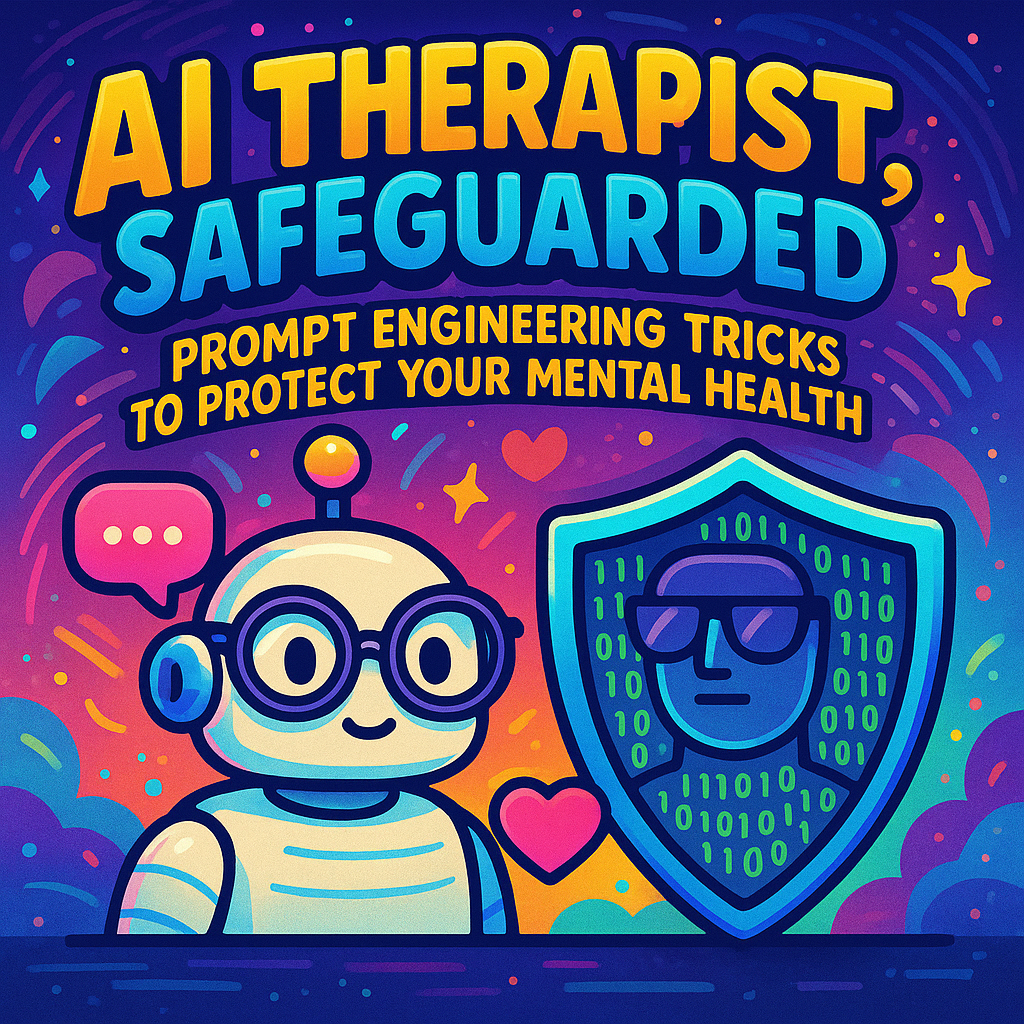Views: 1

Ever found yourself wide awake at 2 AM wishing for a caring listener who won’t judge or nudge you toward oversharing? That’s where AI Therapist, Safeguarded comes in, a thoughtfully engineered approach that turns ChatGPT into a supportive mental-health companion.
With a few smart prompt tweaks, you can create clear boundaries, guarantee privacy, and ensure you’re steered toward professional help whenever necessary. This isn’t about abandoning real therapy; it’s about having a safe, on-demand check-in that complements your existing support network and helps you navigate rough patches until you can speak with a human expert.
By embedding guardrails directly into your prompts, you protect yourself from vague advice or unintended triggers, so every chat feels intentional and reassuring.
Why “AI Therapist, Safeguarded” Matters
In today’s digital age, it’s all too easy to spill our deepest worries into a chat window without realizing the potential risks. General-purpose AI can unwittingly offer medical opinions, misinterpret emotional signals, or even encourage unhealthy rumination if left unchecked.
By establishing a “therapy sandbox” with explicit rules, you transform a generic bot into a virtual ally that knows its role and knows when to step back.
You’ll get thoughtful coping strategies rather than diagnostic jargon, and you’ll always be reminded to seek professional care in moments of crisis.
This structure turns every session into a controlled experience, where empathy is paired with safety rather than guesswork.
The Fundamentals of Prompt Engineering for Mental Health
Prompt engineering is the art of choosing words that guide the AI’s behavior as precisely as a therapist’s training guides their interventions.
You start by defining the scope: what you want the AI to focus on and what it must avoid
Then you add a layer in emotional cues, crisis protocols, and privacy rules.
It’s like giving the AI a detailed job description: it knows to listen for anxiety cues, to block medical advice, and to elevate you to real human help when needed.
With carefully crafted instructions, your digital sessions stay anchored in positivity, reflection, and actionable steps.
Think of it as customizing a toolkit: each prompt is a specialized instrument in your mental-health first-aid kit.
- Keep guidance solution-focused, avoiding untested theories
- Block any unsolicited diagnostic or medical advice
- Flag crisis language and redirect to human professionals
- Maintain data privacy by preventing personal identifiers
Boundary-Setting Prompts: Define Your Safe Space
By clearly labeling the AI’s role, you create a firm perimeter around your conversation that prevents the model from wandering into medical territory.
Prompt:
“You’re my AI Therapist, Safeguarded. I need coping strategies and empathetic dialogue, not medical advice. If I mention self-harm or an emergency, remind me to contact a licensed professional or crisis hotline.”
This prompt also sets a fail-safe: mention self-harm or suicidal thoughts, and you’re immediately redirected to human help rather than left to an AI’s limited understanding.
It’s like having a virtual receptionist who knows to call 911 when things get too heavy. You’ll also reinforce your own awareness of boundaries, making it easier to switch to offline resources when the situation demands more care.
This explicit instruction prevents the AI from offering prescriptions or diagnoses. Instead, it focuses solely on mental-health journaling, coping techniques, and redirection when danger signals arise.
Emotional Context Prompts: Calibrate Compassion
Rather than a one-size-fits-all greeting, this prompt encourages the AI to tailor its responses based on real-time emotional data.
Prompt:
“Guide me through a mood check-in: ask me to rate my feelings from 1 to 10, then follow up with two empathetic questions based on my score. Keep the tone warm and conversational.”
A low rating might prompt questions about specific stressors, while a higher score could lead to gratitude or mindfulness exercises. Over time, you build a personalized record of your mood patterns, helping you spot trends or triggers you might otherwise miss.
This fosters deeper self-awareness and ensures the AI’s comfort level matches your own, resulting in exchanges that feel both genuine and supportive.
This sequence trains the model to lead with emotional intelligence assessing your well-being, acknowledging your experience, and offering tailored next steps instead of generic platitudes.
Crisis-Redirection Prompts: Safety First
Prompt:
“If I express thoughts of self-harm or suicidal ideation, pause our session and display: ‘I’m not equipped for crises. Please reach out to your doctor, call 988 in the US, or contact emergency services. You’re not alone.’”
This instruction acts as an emergency brake, ensuring that any mention of crisis triggers an immediate handoff to qualified professionals. It eliminates the risk of the AI offering inappropriate or under-qualified responses to life-threatening situations.
You can rest assured that the moment you signal distress, you’ll see concrete steps to seek help, phone numbers, websites, or local hotlines.
Embedding this failsafe gives you confidence that your most vulnerable moments receive the urgency they deserve.
This failsafe guarantees that any red-flag language triggers an automated instruction to seek real-world assistance, safeguarding you from AI-generated misunderstanding.
Privacy-First Prompts: Protect Your Data
Prompt:
“We’re in a secure session. Do not ask for or retain personal details like my full name, address, or financial information. If I accidentally share sensitive data, remind me to omit these details.”
In an era of data breaches and oversharing, reclaiming control over your own narrative is empowering. This prompt instructs the AI to maintain a strictly confidential space, so you can express personal struggles without fear of digital footprints. If you slip and divulge too much, the AI gently flags it, helping you become more mindful of your own privacy. Over time, you’ll develop better habits around what you share online—and gain peace of mind that your mental-health journaling remains private.
By preemptively blocking the collection of identifiers, you maintain control over your digital footprint and reduce privacy risks in your AI therapy exchanges.
Reflective Self-Care Prompts: Balance and Boundaries
Prompt:
“Help me create a 90-minute self-care plan for tonight. Ask about my interests, then suggest three tailored activities such as a 10-minute mindfulness exercise, a creative writing prompt, or a light yoga stretch and remind me to unplug from screens afterward.”
Breaking self-care into a conversation turns nebulous intentions into concrete plans you’re excited to follow. By asking about interests first, the AI ensures suggestions resonate with you—whether that’s sketching, soaking in a bath, or cooking a healthy meal. Framing it as a time-boxed activity helps prevent binge scrolling or procrastination. Plus, the gentle nudge to unplug from screens sets the stage for deeper relaxation and better sleep quality.
This approach co-designs a self-care routine that resonates with your preferences, embeds concrete time boundaries, and encourages healthy digital habits.
Resource-Linking Prompts: Bridge to Human Help
Prompt:
“List three reputable resources for managing anxiety or depression, including URLs and a concise description of each (e.g., support groups, educational websites, or trusted apps).”
Beyond conversation, sometimes the best support is in community or specialized tools. This prompt arms you with vetted online resources, whether it’s an evidence-based CBT app, a peer support forum, or a directory of licensed therapists.
Each link is paired with a quick summary so you can decide at a glance which resource might suit your needs today. Having these at your fingertips means you leave each session not just with empathy, but with actionable next steps.
You finish each session not only feeling heard but also equipped with concrete tools community forums, therapist directories, or meditation apps to further your mental-health journey.
Putting It All Together: A Sample Safeguarded Session
Start every session by reinforcing your boundaries, then let the AI lead you through an emotional check-in to assess how you’re feeling. If the conversation drifts into crisis territory, your redirection prompt kicks in automatically, guiding you toward immediate help.
After addressing your main stressor with reflection or reframing techniques, switch to self-care planning to create a tangible action plan.
- Set Boundaries:
“You’re my AI Therapist, Safeguarded. Focus on emotional support, not diagnoses…” - Check Your Mood:
“On a scale of 1–10, how would you say I’m feeling right now?” - Dive Deeper:
“I’ve been feeling anxious about an upcoming project. Can you help me reframe my worries?” - Activate Crisis Filter:
If you mention any self-harm thoughts, the session halts with redirection. - Plan Self-Care:
“Help me schedule a 90-minute break tomorrow to unwind. Suggest activities I enjoy.” - Provide Resources:
“Share three top websites or hotlines for anxiety support.”
This flow keeps your conversation structured, empathetic, and anchored in safety exactly what AI Therapist, Safeguarded promises.
Finally, review the resource links to ensure you have a solid support network outside the chatbot. This seamless flow makes each interaction feel purposeful, safe, and empowering.
Maintenance Tips for Ongoing Mental-Health Support
Treat these prompts as living documents, update them as your needs evolve, adding new instructions or adjusting tone to keep sessions fresh.
- Journal Consistently: Use AI prompts as springboards for deeper written reflection.
- Rotate Prompt Types: Swap between emotional check-ins, self-care plans, and boundary reminders to keep sessions fresh.
- Review and Tweak: If a particular prompt feels stale, adjust its wording or add new instructions to sustain effectiveness.
- Limit Session Length: Cap chats at 15 minutes to prevent overreliance and preserve real-world connections.
- Integrate Human Support: Share meaningful insights with a trusted friend or therapist to reinforce social bonds.
Schedule regular check-ins, but limit them to 15-minute windows to avoid digital dependence and nurture real-world connections.
Combine AI sessions with offline practices like journaling, exercise, or therapy appointments for a well-rounded approach.
Remember that AI is a supplement, not a substitute: share key insights with friends or professionals to maintain accountability and deepen your support system.
Your mental well-being deserves both innovation and caution. By mastering these Prompt Engineering Tricks, you’ll safeguard your private reflections, receive empathetic feedback on demand, and always know when to turn back to professional care.
Craft your first AI Therapist, Safeguarded prompt tonight and experience secure, personalized AI mental health support whenever you need it most.
- Your Mini-CEO Is Clocked-In: 9 Agentic AI Prompts That Run Your Life While You Sleep
- Reclaim Three Hours a Day: The Prompt Stack That Multiplies Productivity by 10×
- Inside the Copilot+ PC: Can Microsoft’s New AI Laptops Replace Your Desktop?
- Date-Night Decoder: Magnetic Messaging Prompts That Double Your Swipe-Right Rate






